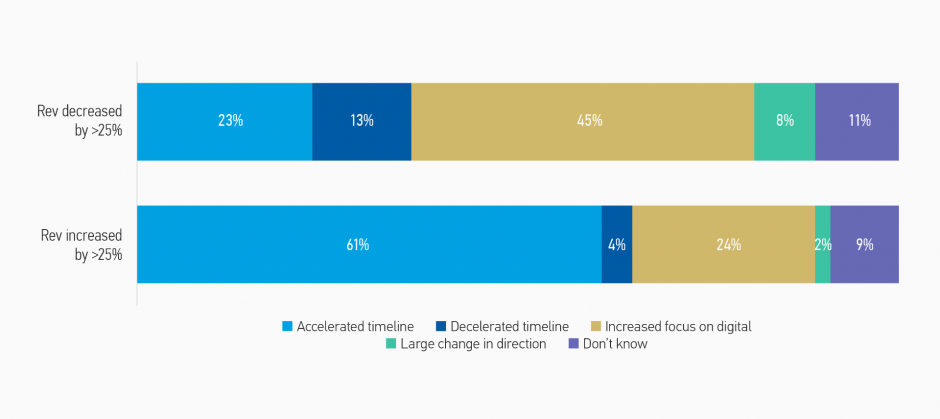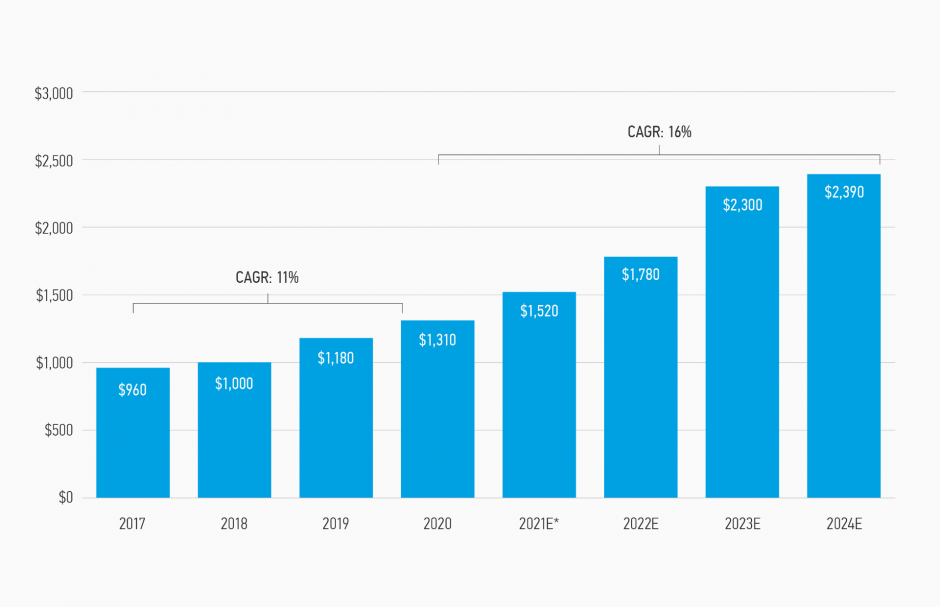
Morgan Stanley IM: Emerging Markets Leaders Focus – Digitalization
In just a few months, Covid-19 has transformed the way we live, from the everyday washing of our hands to the way we travel, shop and eat. But well before the start of the pandemic, consumer behavior was already evolving, sparked by technological developments.
05.07.2022 | 09:07 Uhr
Here you can find the complete article.
The Emerging Markets Leaders strategy team has been closely following and researching the outsourcing of Digital IT Services (DITS) as an industry that would benefit from the rising digitalization trend that we are witnessing across the globe (Display 1) A great proxy for this theme has been the rise of the Digital Transformation, or DX market, which has quickly grown to become a large part of global IT spending (Display 2).
Display 1 Changes in Corporate Strategy in Response to COVID-19

Display 2 Digital Transformation Spending on Technologies and Services Worldwide ($B)

The total DITS addressable market (TAM) estimates have ranged between US$500bn to upwards of US$1tn in 2021, compared to more than US$4tn global IT TAM (which includes hardware, software, services, communication) and US$1tn of dedicated global IT Services.1 According to Gartner, IT spending is expected to increase by low- to mid-single digits while DX spending is estimated to grow between 15-19% on the basis of Compound Annual Growth Rate (CAGR). With segments such as artificial intelligence (AI), machine learning (ML), augmented reality/virtual reality (AR/VR), and virtual/remote workspaces growing more than 30% CAGR,2 we believe this will remain a structural thematic on investor’s radar. We have in fact added this theme to our portfolio after following DITS for some time. But why now, some may ask?
The Covid-19 outbreak accelerated the corporate demand to digitalize. The impact of this pick up has been a significant increase in the organic demand environment, to the point where we believe the longer-term demand will likely be driven substantially higher from new digital native solutions. The expected revenue growth from this theme should drive strong profitability; note that this structural theme is complimentary to the hardware/semiconductor industry.
The following is a simple “real life” example in the new digital world. Consider an airline that wishes to:
- Create a seamless reservation system independent of outside travel agencies;
- Integrate Covid-19 vaccination certificates online within its app;
- Offer automated check-in procedures in coordination with airports via face recognition, issue and verify boarding passes baggage tagging;
- Offer auto-routing of misplaced baggage efficiently, optimizing costs and time.
This simple example is actually a complex issue without an easy
solution. Number 1 is a must-have requirement, while number 2 starts to
differentiate the company. Numbers 3 and 4 then creates a significant
point of differentiation from competitors. This is where the DITS firms
become an important part of the solution.
In our opinion, the pure digital native companies are better positioned to build these types of solutions as they are not encumbered by any legacy businesses. Greater complexity requires an engineering team capable of dealing with that complexity, including a need to develop strong upskilling programs, maintain best-of-breed talent attraction and retention capabilities, all complemented by an attractive corporate culture. In our view it is critical to find the right companies that can hire and nurture strong talent pools, maintain high retention rates, sustain high utilization rates of 75%- 80% (i.e. maintain spare capacity), aim for high organic growth rates, and establish high-teens to low-20s operating margins. Geographical cost arbitrage is also a factor in the equation. We believe the successful company needs to get comparable or better talent at cheaper than customer location pricing. In that scenario everyone wins—customers are happy (high-quality work at lower prices), employees are happy (intellectually challenging high-quality work at better than comparable local remunerations), and the company itself makes strong profits (cost arbitrage of talent to produce high-quality offerings) in a structurally growing revenue pie.
Two essential factors are the relative “brand strength” of these firms, and the geographical talent availability. With respect to branding, firms need to command good relative placement within peer sets to attract top talent. Typically, their internal work cultures, remuneration, capability, and talent fostering form this brand power. If done right, there is a significant “soft moat” that gets built on three foundational elements for successful companies. Assuming competitive remuneration within the peer set is a given, these firms are able to:
- Generate enough brand pull for talent to join;
- Provide positive employee-oriented cultures to help retention;
- Offer enough upskilling and opportunities for each employee to grow as a professional.
In our process, these soft moats combine with some hard numbers—the
bench size vis-à-vis the customer slate size, and the bench
utilizations—which are additional key parameters for us to assess brand
strength. Our guiding principle is that bench strength needs to be
right-sized relative to the business opportunity, optimally utilized at
all points, ultimately providing differentiation of opportunities across
multiple skill sets for each individual employee to grow.
It is interesting to note that firms delivering on all of these foundational elements are typically naturally strong environmental, social and governance (ESG) companies, with social and governance factors being the standouts. This is important to our team, and our firm. As for talent recruitment, the key players are centered in India, China, Brazil, Eastern Europe, ASEAN, and the U.S.—with the majority based in Emerging Markets.
Finally, there is a pyramidal structure when it comes to the industry. On the base are several traditional IT outsourcers who are trying to develop digital capabilities (traditional Indian IT players), with the middle section occupied by more global companies. The top of the pyramid has fewer players, including some of our portfolio holdings. There is also a set of firms that offer IT consulting and strategy work alongside IT services. The work at the top end is more structural, premium and lower volume, while at the base it is more commoditized with high volumes. Business consulting may or may not be a part of the DITS offering, but if offered, tends to be premium in nature.
We see a “sweet spot” in the middle-high section of the pyramid, with a premium footprint where scaling up is much faster with good margins. On this part of the pyramid, the pure plays are smaller in number—and this is where we focus exclusively. Within this construct, we believe our holdings are the best-placed players due to their premium positioning, and their stage in the companies’ development cycle, positioned in the sweet spot. We have also invested into India digital IT specialists, which in our opinion has the right DNA with a smaller relative size that enables them to scale up structurally and join the sweet spot. Our view is that these firms generally have the right kind of leadership teams, operating spaces, and moat characteristics that can potentially lead to a sustainably high Return On Invested Capital (ROIC) (20%+) with strong, repeatable revenue growth, all of which the Emerging Markets Leaders Strategy finds highly attractive.





Diesen Beitrag teilen: